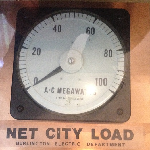 Maryette Haggerty Perrault Jun 7, 2014 03:57 |
Thanks for your proposal jbakervt!
I think that realtime energy consumption reporting is a very intriguing idea particularly for city/state/federal facilities. I would be interested to see specific ideas on how to present the data to the general public. The concept of a kWh of electricity or therm of natural gas is easily lost on most people, particularly when they only have their monthly residential utility bills as a reference point to compare with the consumption of a 800,000 square foot federal office building or a multi-building national lab campus for example. Putting a dollar sign up there will definitely make it more tangible, but other benchmarks can also be helpful such as giving a reference point for what the consumption in that particular building could be if it were operating efficiently. This could of course also be used to promote efficiency upgrades have been implemented as well.
You may already be aware but there is considerable federal guidance on energy tracking and disclosure from the US government which might be of assistance to you on this proposal. Some that come to mind include:
Energy Policy Act of 2005 (EPAct 2005) - http://energy.gov/sites/prod/files/2013/10/f3/epact_2005.pdf
Energy Independence and Security Act of 2007 (EISA 2007) - http://www.gpo.gov/fdsys/pkg/BILLS-110hr6enr/pdf/BILLS-110hr6enr.pdf
Executive Order 13423 - http://www.gpo.gov/fdsys/pkg/FR-2007-01-26/pdf/07-374.pdf
Executive Order 13514 - http://energy.gov/sites/prod/files/2013/10/f3/eo13514.pdf
Additionally the USGBC and its LEED Rating system encourage projects to include "occupant engagement" which is right along the lines of your proposal as well - http://www.usgbc.org/node/4561949?return=/credits/existing-buildings/v4
Best of luck with the proposal!
|
 Mark Johnson Jun 10, 2014 03:23 |
Great comments Mary. Haven't read each of the links, but real time metrics could come from a Government-wide "Eco Dashboard" (with metrics providing nominal, rank-order summaries of the most and least efficient Agencies, Components, Companies and Organizations). OMB could make this happen.
Fyi - Here's this year's DoE Energy Star award winners - lots of good info - each winner's logo is a hyperlink.
http://www.energystar.gov/about/awards/2014-energy-star-award-winners
|
 Brian Filiatraut Jun 16, 2014 02:12 |
I agree with Mary's insightful comments. Perhaps you could pair your proposal with available programs/initiatives already out there. LEED's new rating system (http://www.usgbc.org/leed/v4/) is requiring, more or less, what your proposal suggests. You might want to use their "Dynamic plaque" as a guide.
Perhaps, provide an example within the commercial, residential, and industrial sectors of each building's potential with best practices in O&M and retrofits. This will make your proposal more substantive and tangible.
Best,
Brian
|
 Dan Whittet Jun 17, 2014 10:15 |
Good comments above. I would add that the Energy Star program is in place and does a good job of providing building metrics, let's develop ways to use the tools that work better rather than fragment our efforts.
One piece of feedback I get a lot is the perception that building dashboards USE energy, are often too much information for most tenants or less relevant than they could be. I wonder f as Climate Change begins to really impact peoples lives we could develop a tax incentive (or penalty) based on building efficiency that would effect everyone who uses the building.
|
 Mark Johnson Jun 17, 2014 10:12 |
Making Dashboards user friendly and effective would require close coordination and discussion among policy authorities, users/tenants, construction SMEs, climate change SMEs/organizations, etc. to nail down what Metadata provides relevance and value, thereby avoiding too much info for consumption. There would be additional discussion on server connectivity - e.g., Federated Databases. Yep, Energy Star does a very good job. Thank you. Mark
|
 Nancy Cruz Jun 19, 2014 11:25 |
Great idea - but how can we incentivize people to take action once they receive this information? Especially if these signs are on public buildings, individuals might not strongly associate the energy costs of the building with their wallet.
|
 Jason Baker Jul 29, 2014 04:51 | Proposal contributor
Thanks for all the comments.
Some things I would add (a bit late now):
Data on buildings would be available online as well.
An interactive kiosk-style interface could be used to delve into detail views, do comparisons.
Historical consumption and cost data would be included, so buildings that have undergone renovations can show how much has been saved by building "green", payback period, etc.
Use of visual display of information to capitalize on people's natural intuitive abilities and directly impart information.
|
 Jason Baker Jul 29, 2014 04:22 | Proposal contributor
To address the concerns of those who wonder what information to show or how it will impact attitudes and behavior please see my references.
Simple information, delivered to the right people at the right time, is a very effective way of influencing the system of public building construction and renovation, which is highly directed by public opinion.
|
 Climate Colab Aug 5, 2014 08:38 |
Both the EU and UK have building energy consumption labeling schemes so this idea is not new, although the idea of a running calculator showing energy use and cost signs is not common. However, this proposal does not thoroughly communicate how this would implemented and mechanisms for public engagement around the displayed energy use.
As this has been done in a number of countries it would be good to factor in any anaylsis of how that has worked over time -- benefits, take up, cost savings to those who have used it vs cost to install and provide, etc. and to build on those learnings for a model that would incorporate improvements for the best possible outcomes. Installation costs could be an issue, particularly in lower income areas, so it would be good to explore the cost benefits for those charged with funding the system and the necessary technology. This is a good idea that could build on results to date to provide a best practise option for those considering taking up such a system.
|
